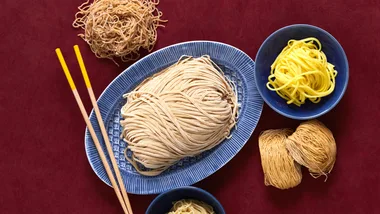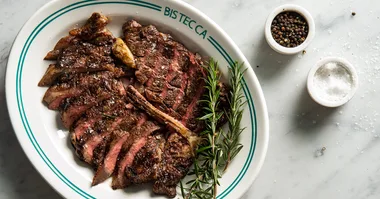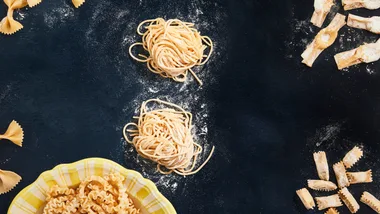No other fruit spells Christmas like the cherry does. Brigitte Hafner gets pickling to make the most of summer’s bounty.
Every year for my birthday I would ask Mum to make me a Black Forest cake. She used to make a rather spectacular version of this layered chocolate cake, sodden with kirsch and morello cherries. My favourite bit was standing on a chair licking the cherry pot and watching the layers being covered in a mountain of whipped cream and grated dark chocolate.
I have loved sour cherries since my earliest birthday cakes. I now look forward each year to the end of December, when I expect my uncle Wilfried to call and say, “Are you ready for the cherries?” He has two large morello cherry trees on his farm in the Strzelecki Ranges that ripen around this time. He picks almost the entire crop for me in exchange for wine and I set about pickling, preserving and making jam from this glorious fruit. His cherries are small and ruby-coloured and have an intense flavour with mouth-puckering sourness. They can really only be enjoyed cooked.
Once cooked, a wonderful transformation takes place: sour cherries develop a deeper, more complex flavour than sweet cherries. Turned into jam they make a decadent breakfast treat; sweetened and thickened with a little cornflour they make a beautiful sauce for pancakes; or sandwiched with cream in a freshly baked sponge they become a delicious dessert.
We turn most of Uncle Wilfried’s cherries into jars of spiced pickled cherries to go with our pork and duck terrine. It’s a very simple preparation of red wine vinegar, sugar, star anise, cinnamon, allspice and pepper. We leave them for three months, by which time they have turned a deep magenta with an intense flavour. They’re absolutely beautiful with duck cooked any way, roast pork belly, and of course pork and duck rillettes or terrine.
One of the simplest ways to prepare morello cherries is to preserve them in sugar. For every kilo of cherries bring two cups of sugar and 750ml water to the boil. Add the cherries and simmer for two minutes, then pour into sterilised jars and seal. If you want to keep them for a long time, it’s best to boil the filled jars in a large pot of water for 15 minutes before cooling and storing them in a cool, dark place.
They can then be easily used in desserts and cakes. One of my favourite simple desserts is morello cherries cooked in syrup with star anise and cinnamon, served with vanilla ice-cream and Valrhona chocolate sauce. And I love a traditional baked cheesecake with a layer of morello cherries on the bottom. They’re also lovely baked in an almond tart.
I generally don’t like to remove the seeds before cooking (except when making jam) – partly because I’m lazy, and partly because it’s a waste of precious juice and flesh. I also think the seeds contribute a subtle almond flavour during cooking. Once cooked, simply press the cherries through a coarse sieve or colander to get the seeds out.
Trevor Holmes of Red Hill Cherry Farm has been growing cherries for more than 42 years. Almost all the cherries – both sweet and sour – from his 4000-plus trees are sold as pick-your-own. When his customers ask, “Why can’t we get this flavour in the cherries we buy from the market?”, his reply is straightforward. When cherries are picked fully ripe from the tree, he explains, the flavour’s incredible. Cherries you buy at the market are picked four to five days before they are fully ripe. (Since cherries take only six weeks from blossom to harvest, that’s a significant time period in terms of flavour development.)
It’s also worth noting that the soil in Red Hill is excellent and that the sustainable agricultural practices at Red Hill Cherry Farm incorporate organic and biodynamic principles. Further, Holmes doesn’t irrigate very much so the cherries aren’t pumped full of water. Pretty simple: pick thoughtfully grown fruit at its ripest point directly from the tree and enjoy a superior experience.
Cherries will keep well in the fridge for several days. They only need a light wash just before eating, and it’s best to keep the stalks on to help them stay fresh. When buying cherries look for bright, shiny fruit with no blemishes or sunken, bruised flesh. Dull skin usually indicates they’re past their prime.
Sweet cherries eaten on their own are such a delight that there’s little embellishment a cook need bring to them. That said, this Christmas I’ll be making a coconut and lychee trifle with fresh (pitted) cherries set in sweet wine jelly. The possibilities are endless.
 Antonia Pesenti
Antonia Pesenti









